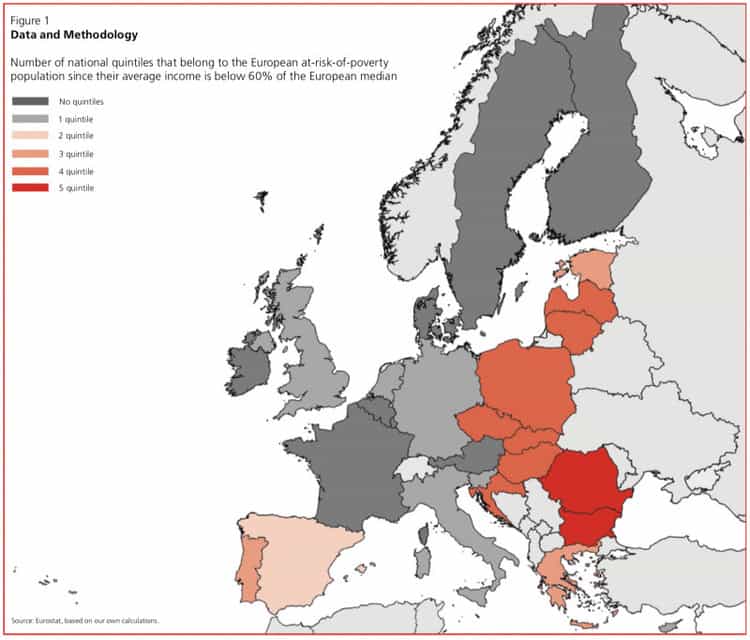Eurostat, the EU’s statistical office, has published official figures on pan-European poverty and inequality since 2005, in the form of the poverty rate and the S80/S20 ratio. The poverty rate is the proportion of the population which earns less than 60 per cent of median income; since this is a measure of relative rather than absolute poverty, it is also referred to as the at-risk-of-poverty rate. The Eurostat figures for the EU as a whole are calculated based on averages of the national rates, weighted according to population size.
This way of calculating the figures is methodologically flawed and massively underestimates the real extent of poverty and inequality, because it neglects the vast differences in income among the member states. These differences come out especially high if the incomes are compared using market exchange rates, although substantially lower if they are compared using purchasing-power-parity (PPP) exchange rates, which recognise that the same earnings represent higher purchasing power in poorer countries.
Almost 142 million Europeans are at risk of poverty
For several years now, we have been publishing more realistic estimates of pan-European inequality, which take account of both intra- and inter-country income differences. We have supplemented this analysis with an estimate of the pan-European poverty rate which utilises essentially the same method. The values calculated using this method are significantly higher than the official figures.
It might be objected that it is inappropriate to classify people who are relatively well off in their own country as belonging to the poor of Europe. But this nation-centric view underestimates the extent to which the social situation in different countries has become Europeanised, with consequences for immigration and social cohesion.
National poverty rates in the EU vary between over 25 per cent in Romania and less than 10 per cent in the Czech Republic. For Germany, the figure is 16.5 per cent (2016). The official Eurostat figure for the EU as a whole is 17.3 per cent, which puts poverty in the EU only slightly higher than the level in Germany. However, if a proper EU-wide poverty threshold is calculated, the figure comes out significantly higher.
We estimate the at-risk-of-poverty threshold for the EU as a whole (60 per cent of median EU income) to be around €9,760, based on market exchange rates or €9,780, based on PPP exchange rates. The bulk of households which are poor on an EU-wide comparison, with an income below the threshold, are in poorer member states, primarily Bulgaria and Romania, which not only have the lowest per capita income but also the highest poverty rates. Practically all households in these member states count as poor on this pan-European comparison. In other member states, correspondingly fewer households fall into this category. In Scandinavian countries, for example, no quintiles are below the threshold. The map below (figure 1) offers a rough overview of how matters stand for each individual country.

By our estimate, if market exchange rates are used the EU-wide poverty rate is 28.2 per cent (equivalent to around 142 million out of a total EU population of around 500 million), which is higher than in any individual member state. If PPP exchange rates are used instead, the figure falls to 23.2 per cent (equivalent to around 117 million), which is higher than the Bulgarian poverty rate. The official Eurostat poverty rate of 17.3 per cent is equivalent to a figure of just under 87 million people in the EU at risk of poverty. This figure thus leaves out either 30 million or 55 million below the at-risk-of-poverty threshold, depending on whether this threshold is measured using market or PPP exchange rates.
The poverty rate has decreased slightly since 2015, with the number of people at risk of poverty in the EU falling by around 4 million. This fall is equivalent to just under one percentage point. Any progress may be due to relatively strong growth, especially in the poorer countries.
As figure 2 illustrates, pan-European inequality fell rapidly until 2009, rose again in 2010 and has been coming down only slowly since. As a result of two relatively poor and populous countries, Bulgaria and Romania, joining the EU in 2007, inequality in the EU-27 is significantly higher than in the EU-25. Factoring in differences in purchasing power does have a significant impact: inequality is significantly lower. The official Eurostat figure for the S80/S20 ratio, calculated on a methodologically flawed basis, continues to oscillate around the value of 5, though it too has fallen slightly (by 0.1).

As welcome as the slight fall in inequality between 2015 and 2016 is, the rate of reduction is still far slower than between 2005 and 2009. It marks little change from the stagnant level observable since 2011 (especially when measured using market exchange rates). The causes lie, first, in a slight decline in average intra-country inequality (as evident in the fall in the official Eurostat figure) and, secondly, in the continued successful catch-up growth of many poorer member states.
Reducing poverty and inequality
As noted, inequality is one of the key drivers of higher immigration, which in turn fuels feelings of anxiety and insecurity and the rise of populism. Immigration was a key factor behind ‘Brexit‘ and is a central rallying cry for many populist parties across Europe, including in Scandinavia, France, the Netherlands, Germany, Italy and central and eastern Europe. High income differences between countries with close economic ties also contribute to the outsourcing of labour-intensive production stages, which in turn threatens wages and employment in regions which previously had enjoyed greater economic prosperity as the home of low-skilled manufacturing industries.
These are all reasons to place greater emphasis on reducing inequality. EU-wide inequality and poverty can be brought down in two ways: (a) by reducing intra-country inequality or (b) by reducing inter-country inequality.
(a) Intra-country inequality is increased by welfare cuts and labour-market deregulation, technological change and globalisation. All these causes can be addressed by government policy. For example, in Germany the introduction of a minimum wage has halted the rise in inequality observable since 1995. In the EU, a stricter Posted Workers Directive could curb wage competition. In his most recently published book, the late Tony Atkinson presented numerous suggestions for how intra-country inequality could be reduced, covering all categories of cause. Unfortunately, the EU’s economic-policy advice and the requirements it has imposed on indebted countries have instead tended to increase inequality.
(b) Inter-country inequality is rooted in complex historical causes with social, political and economic dimensions. Several countries have however managed to close the historic gap with other countries, by means of successful growth policies. Worthy of particular note in the EU is Ireland, which rose from being one of the poorest members of the EU-15 to the second-richest on a per-capita-income basis—although this was achieved in part by problematic and not easily generalisable methods (tax competition, transfer-pricing manipulation). But southern and central-eastern Europe have also enjoyed sustained periods of higher growth than the rich EU core countries. Although the EU supported this growth through its regional policy, it then undermined it through its misguided response to the sovereign debt panic, in imposing austerity.
In its new medium-term financial plan for 2021-27, the EU should give high priority to promoting growth, employment and social security in the poorer member states on its periphery, and adopt appropriate fiscal policies, such as a eurozone budget and finance minister. It should support investment activity, stabilise banks in all countries—by introducing EU-wide deposit insurance—and protect sovereign debts from market panic.
The recent drop in Europe’s poverty and inequality rates is a welcome break from the stagnation of the preceding years. But, given the vast scale of the problem, which is underestimated in official figures, it represents far too small a step in the right direction. Stronger progress and more decisive policies will be needed if the disintegration of Europe is to be prevented.
This article is based on a longer version published by FES. See also our focus page What is inequality?
Michael Dauderstädt is a freelance consultant and writer. Until 2013, he was director of the division for economic and social policy of the Friedrich Ebert Stiftung.

